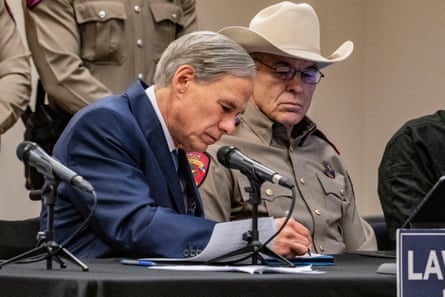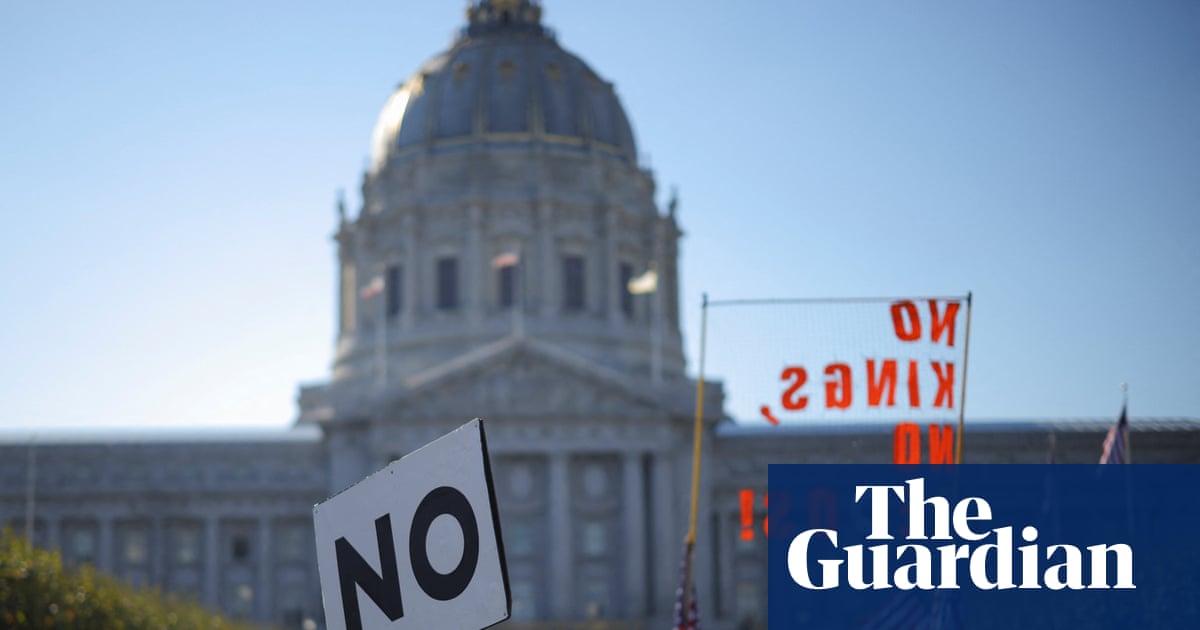An unverified rumor that Venezuelan gang members were preparing to kill police officers spread like wildfire through US law enforcement agencies last year, internal records reveal, only for federal officials to later quietly acknowledge the claim was mistaken.
The intelligence report, which appears to have first been disseminated by a local New Mexico police department in July 2024, suggested that the Tren de Aragua (TdA) gang had directed its members to “fire on or attack” law enforcement. The vague assertion quickly traveled among law enforcement agencies. It even made its way into a formal proclamation by Texas governor Greg Abbott, and was repeated by Republican Congress members as evidence of the dangers of Venezuelan immigrants and Democrats’ border policies.
Months later, however, the Federal Bureau of Investigation wrote in an internal report that claims of a TdA “directive to actively target US law enforcement” were inaccurate.
There has been no public acknowledgement of misstatements.
The documents were uncovered by Property of the People, a government transparency non-profit, which has made records requests related to US authorities’ discussions of TdA and shared files with the Guardian.
The records, TdA experts said, suggested that a wide range of powerful law enforcement agencies lacked a basic understanding about the gang and its operations.
In recent months, the stakes of dubious and alarmist claims about TdA have become increasingly high. Trump’s administration has carried out seven lethal strikes on vessels near Venezuela, in some cases claiming the military was targeting TdA members, without providing concrete evidence, and United Nations experts have said the attacks violated international law. The Department of Homeland Security has also used unsubstantiated claims of TdA affiliation to deport Venezuelans, without due process, to a notorious El Salvador prison – and has moved to revoke the legal status of roughly 600,000 Venezuelan immigrants.
TdA began in a prison in the Venezuelan state of Aragua, and experts say there is no evidence the group has a clearly organized structure in the US, strongly rejecting claims of an “invasion”. Allegations of a TdA call to attack police were especially far-fetched, scholars said.
But the narrative, records show, quickly took hold.
‘Green light to attack law enforcement’
The rumor about TdA’s threats to US police was first documented on 27 July 2024 by the Albuquerque police department (APD) in New Mexico. In an “Officer Safety/Awareness” bulletin distributed to local law enforcement partners, APD cited warnings from Homeland Security Investigations (HSI), which conducts investigations for Immigration and Customs Enforcement (ICE).
“[Albuquerque] HSI has received information from credible human sources out of Colorado that the Tren De Aragua criminal organization operating in Denver have been given a ‘green light’ to fire on or attack law enforcement,” APD wrote in a one-page bulletin. “Due to the access of these informants this intelligence is believed to be credible at this time.” HSI in New York had also received this information, APD said, encouraging its officers to “remain vigilant”.
The bulletin provided no further detail.
On 28 July, the day after the APD alert, Customs and Border Protection (CBP) issued a warning about HSI’s “green light” report, telling agents to “maintain a heightened sense of awareness” and “always wear their body armor”. The one-page alert said CBP had encountered a total of “approximately 26 known/identified TdA members” in fiscal year 2024.
The next day, DHS warned of the alleged TdA threat to officers in an email to state and local agencies, which the National Sheriffs’ Association shared with its members across the US. A sheriff’s official in Santa Barbara, California, then forwarded the report to others in his office, writing: “Obviously we’re not in Denver or New York but who’s to say there aren’t associated members in our county.”
A 31 July New York police department alert acknowledged the “green light” warning and said it believed TdA members in Venezuela had shot at police when fleeing. But NYPD’s intelligence bureau, the alert said, “notes that this does not indicate TdA will target uniformed officers without prior engagement”.
Still, in the following weeks, the APD and CBP “green light” warnings were shared by the New York State Intelligence Center, a multi-agency counter-terrorism group; US army north, the domestic defense command; the Major County Sheriffs of America, an association of agencies; the San Diego sheriff’s department; the Northwest High Intensity Drug Trafficking Area (HIDTA) program, working with law enforcement in Washington state; and the International Union of Police Associations, a lobbying group.
It’s unclear if the agencies and groups took steps to confirm the rumor’s veracity or relevance to their networks.
Internal emails from Washington state show a Kirkland police department analyst sought to “vet the info” with the state’s “fusion center”, a consortium of agencies. A fusion center analyst responded that the FBI was not aware of any TdA presence in Washington. A Kirkland spokesperson said this week the department took no further actions.
Gilbert Gallegos, an Albuquerque police spokesperson, said in an interview that APD disseminated the “green light” warning to its local partners and did not intend for it to be publicly shared. His recollection was, at the time of the bulletin, there had been a local homicide involving a Venezuelan suspect and victim, but, “I don’t know that it had any kind of gang connection other than they were from Venezuela.”
Gallegos said he was not aware of any evidence of a TdA presence in his region and APD had no intelligence about potential Venezuelan gang attacks on police beyond what an HSI agent in Colorado had shared. Still, he said, “if there was something that threatened law enforcement, we definitely wanted our officers to know about it.”
‘Unverified and inflammatory’
Conservative news outlets, including Fox News and the New York Post, along with NewsNation, reported on the TdA threats, citing the Albuquerque and CBP “green light” memos.
Texas governor Greg Abbott, a staunch Trump supporter, cited the “‘green light’ to fire on … law enforcement” in a September 2024 state proclamation calling TdA a “terrorist organization” and condemning Joe Biden’s “open-border policies”. His public safety director called TdA members “cockroaches”.
Then Colorado congressman Greg Lopez, a Republican, used the rumor to attack Biden’s DHS secretary, condemning “calls for brazen violence against our nation’s police officers”, claiming DHS had “chosen not to act”. Senator Ted Cruz cited the “green light” quote in a letter to DHS, saying a “massive increase in crime committed by Venezuelan illegal aliens is a direct result of this administration’s purposeful policies”.
It wasn’t until several months later that federal officials cast doubt on the narrative.
In December, the FBI and army’s National Ground Intelligence Center held a TdA briefing in Seattle and shared follow-up materials with officials from Washington, Oregon, Alaska, the US Bureau of Prisons, DHS, the Drug Enforcement Administration and other agencies, email records show.
The materials included warnings that certain tattoos and emojis could be signs of TdA affiliation – claims that experts have said were “ludicrous” and “baseless”.
In a section on “officer safety”, the FBI summarized TdA’s “history of targeting, extorting and/or recruiting law enforcement” outside of the US, but then said: “Despite reporting in August 2024 indicating TdA issued a ‘green light’ on violence against US law enforcement, it appears the order is primarily defensive in nature, rather than a directive to actively target US law enforcement.”

The FBI did not respond to inquiries.
Tricia McLaughlin, DHS assistant secretary, said in an email: “Any effort by the Guardian to smear law enforcement intelligence or downplay the threat that Tren de Aragua poses to our country is disgraceful and absurd.”
McLaughlin said last year’s “be on the lookout” alert was created by local law enforcement, “and out of an abundance of caution for the safety of law enforcement, HSI Denver created a similar one.” Colorado officials also publicly acknowledged the alert, she said.
“Information sharing is a critical aspect of law enforcement,” she said. She noted Trump has designated TdA a foreign terrorist organization, saying the president and DHS secretary, Kristi Noem, “will not allow foreign terrorist enemies to operate in our country and endanger Americans”.
Gallegos, the Albuquerque spokesperson, said he was not aware of the FBI’s correction. He said APD officials were troubled last year to see how far its bulletin had spread: “There was some concern that it could become politicized and I think it did.” His city “has an inclusive attitude towards immigration” and APD tries “not to paint everyone with a broad stroke and inflame tensions”, he said, but “our overriding concern was officer safety” and APD could not control what other agencies did with its report.
A CBP spokesperson did not respond to detailed questions about its “green light” report, saying in an email: “CBP is working closely with all of our federal partners, sharing information, to make sure that law enforcement personnel can do their jobs safely.”
A Denver police (DPD) spokesperson said the department “monitored and made officers aware of the safety concerns” raised by the “green light” reports, but said “there were no direct threats made to DPD officers”.
Megan Noland, executive director of the Major County Sheriffs, said in an email: “As we do whenever we receive threat information that is deemed credible, we forwarded that information to our members. Our member agencies continue to monitor any important intelligence related to TdA.” A HIDTA spokesperson said it “had no original or unique information” about the threat and was sharing warnings that had been publicly posted.
Spokespeople for the other agencies and politicians that shared the report did not respond to inquiries.
Ryan Shapiro, executive director of Property of the People, said the records showed “this unverified, inflammatory mischaracterization fueled an ever-escalating game of law enforcement telephone”.
“This is typical. Thinly sourced intelligence products get repackaged as new security reports, receive coverage from rightwing media, and then get funneled back into additional law enforcement alerts,” Shapiro said. “It’s a self-reinforcing ecosystem of politically motivated distortion and paranoia.”
‘Real consequences’
Scholars on Tren de Aragua said the notion that TdA members in the US would have a directive to kill police was incongruent with the group’s operations.
Rebecca Hanson, professor at the University of Florida’s Center for Latin American Studies, who has interviewed police in Venezuela about TdA, said while there have been armed confrontations between the gang and police, there was no evidence of TdA ordering attacks on Venezuelan officers: “There is not a single case of Tren de Aragua using that policy in Venezuela. It is not a part of their playbook.”
Hanson, who reviewed the records for the Guardian, said gangs, generally, would only order attacks on police under specific and limited circumstances, since broad and random violence against the state could be a costly strategy that hurts their economic interests.
TdA in particular is decentralized, and there was no evidence of any formal hierarchy or leadership in the US, she said.
“So where is this ‘green light’ coming from? Ostensibly, it would be from someone high up giving the order to lower-ranking members. But Tren de Aragua isn’t organized that way … It would seem very strange for Tren de Aragua to have never done this before and then start in the US.”
Hanson said she was also highly skeptical of the FBI’s claim that there was a call for “defensive” violence against police. The FBI’s own report, she noted, acknowledged “gaps” in its knowledge with a list of unanswered questions, including: “Who are the TdA leaders that direct or sanction activities within or outside of the United States and where are they located?”; “What are TdA’s rules of order … for conducting criminal activity within the United States?”; and “How autonomous are TdA subsets from TdA leadership?”
Without answers to those questions, the FBI could not credibly make any claims about TdA directives, Hanson said: “It very much worries me about the type of information they are looking for and confirming before making these very bombastic claims … It makes me wonder how much police departments care about testing the veracity of these claims.”
Phil Gunson, a Caracas-based analyst for Crisis Group, an international NGO, said it seemed “completely implausible” that any purported TdA members in the US would be in a position to give orders, or would have an incentive to call for police killings.
Gunson said he was concerned about the impact of these “exaggerated, cartoonish” claims about TdA: “You can trace a direct line from this narrative that bolsters the case that TdA is a nationwide terrorist organization to these clearly unlawful efforts by the Trump administration to demonize and even kill Venezuelans on the basis that they are TdA.”
There is a long history of US officials falsely painting immigrant groups as criminal and violent to justify crackdowns on migration, said Deep Gulasekaram, professor of constitutional and immigration law at the University of Colorado, noting how propaganda about the dangers of Chinese immigrants, including claims that they threatened white women, was used to justify the Chinese exclusion act in the late 1800s.
“It is so easy in this country to sell a story about immigrant danger, and the claims have such staying power,” he said, noting no study has ever credibly found a link between immigration and crime. “It’s amazing how fast falsehoods about noncitizens and their danger will make its way through every media channel.”
That dynamic, he said, played out in Colorado last September when there were reports that TdA had “taken over” an apartment complex in the city of Aurora, claims police officials ultimately said were false. Still, Trump, on the campaign trail, said: “Venezuelans are taking over the whole town, they’re taking over buildings.”
Lisa Martinez, University of Denver sociology professor, watched as rumors about TdA controlling Aurora spread among her neighbors in online forums: “People really bought into these tropes and the story took on a life of its own … The irony was if one really wanted to see what was happening, you could go to Aurora and see [that] these activities were not happening.”
She said she was increasingly concerned about misinformation leading to racial profiling: “A lot of these rumors and sentiments are false, but part of what makes it so dangerous is that it can have very real consequences for people who become afraid to go to work, to send their children to school, to live in their communities. People start to feel targeted, and sometimes they are.”

 German (DE)
German (DE)  English (US)
English (US)  Spanish (ES)
Spanish (ES)  French (FR)
French (FR)  Hindi (IN)
Hindi (IN)  Italian (IT)
Italian (IT)  Russian (RU)
Russian (RU)  4 hours ago
4 hours ago
























Comments